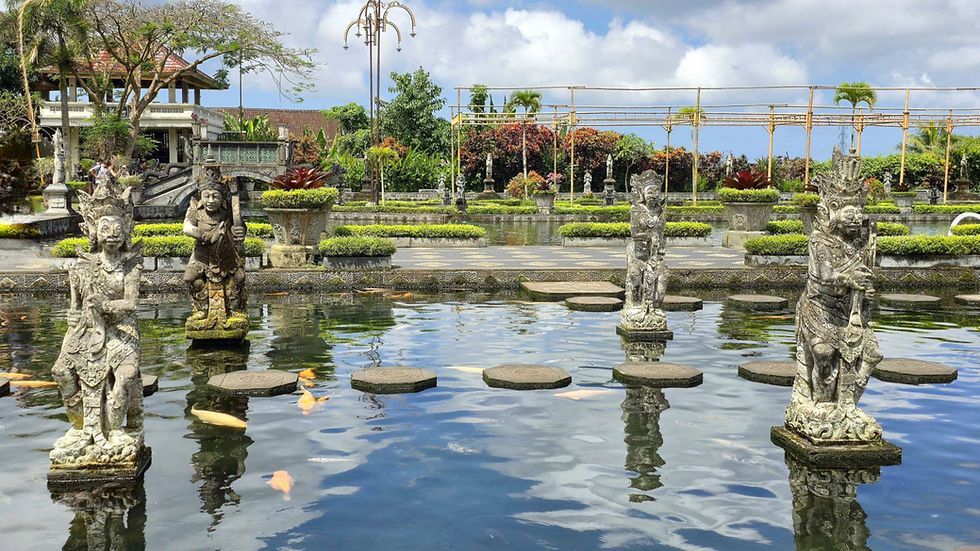Tirta Gangga Water Palace
- Shannon
- Sep 3
- 4 min read
Updated: Sep 16
The Last Raja’s Sacred Sanctuary
Nestled in the eastern highlands of Bali, in the quiet village of Ababi at the foot of Mount Agung, Tirta Gangga is a royal water palace steeped in beauty and spiritual reverence. Commissioned by the last Raja of Karangasem in 1946, this sacred estate pays homage to Balinese Hindu devotion. Its name, meaning “blessed water from the Ganges,” reflects its role as both a royal retreat and a site for spiritual purification and ceremonial bathing. Across its grounds, reflecting pools, stone fountains and silent guardian statues are woven into perfectly manicured gardens. Once the private refuge of Balinese royalty, it endures as a hallowed space of devotion and myth.

Spanning three acres, Tirta Gangga bears both the scars and triumphs of history. Nearly reduced to ruins by the catastrophic eruption of Mount Agung in 1963, the estate rose from the ashes through a remarkable act of devotion. Though the palace was spared from direct lava flow, it suffered extensive damage from falling ash, debris and aftershocks. Many of its delicate structures collapsed or were buried under volcanic material. In the face of such destruction, the King himself led the restoration effort, laying stones with his own hands. Today, the palace stands not only as a restored royal retreat but as a living legacy, lovingly preserved by his descendants.

Imbued with the charm of Old Bali, the water garden is meticulously laid out across three symbolic terraces, aligned from east to west, each representing a different realm in Balinese cosmology. The highest terrace, Swah, symbolises the heavens and the divine, offering a sense of spiritual elevation. The middle terrace, Bwah, represents the earthly realm of humans, where vitality and life are most present, with flowing water and koi ponds. The lowest terrace, Bhur, symbolizes the underworld, a place of grounding and connection to the ancestors. Together, these three levels create a harmonious balance between the realms, embodying the Balinese belief in the interconnectedness of the divine, human and spiritual worlds.

At the southern edge of the garden lies Demon Island, a small island surrounded by a shadowy pond, adding a contrasting and symbolic element to the peaceful garden. Named after the mythological demon Raksasa, this island represents the darker forces of Balinese mythology and serves as a reminder of the balance between light and darkness in the universe. The dark pond surrounding it contrasts with the serene water features of the garden, symbolising the integration of both opposing forces in the natural and spiritual world. This balance is central to the garden's design, reflecting the spiritual principle of Tri Hita Karana, the harmony between humanity, nature and the divine.

At the centre of Tirta Gangga is its most prominent feature, an eleven tiered lotus fountain, a traditional Balinese design often used in royal and temple architecture. Surrounding the fountain are large koi ponds, maintained for both aesthetic and symbolic purposes. These ponds, along with the fountain, were part of the original 1946 construction and were carefully rebuilt after the eruption of Mount Agung.

The connection between Mount Agung and the dark legends surrounding Tirta Gangga is deeply rooted in the island's spiritual and cultural traditions. Mount Agung, Bali’s most revered yet feared volcano, is considered the home of the gods and a sacred point of connection between the earth and the heavens. The Balinese people, especially those in the eastern regions near the water palace, have long believed that the mountain is inhabited by powerful spiritual forces, gods, goddesses and ancestral spirits, who must be appeased through rituals and offerings to maintain balance and harmony.

In ancient times, the local Kings would perform ritual sacrifices, sometimes involving animals or humans, to appease the gods and spirits of the volcano. These sacrifices were believed essential to ensure protection from natural disasters and to guarantee the safety and prosperity of the people. However, these rituals carried a sense of danger, as the mountain’s guardians were seen as wrathful beings. If the offerings were neglected or not performed correctly, the spirits of the mountain were thought to become vengeful. This belief is deeply intertwined with the catastrophic eruption, which for many Balinese, was not just a natural disaster but a divine retribution for failing to properly honour the mountain’s spirits. The eruption caused widespread devastation and claimed the lives of over 1500 people. In the aftermath, some locals believed the eruption was the result of the spirits, whose anger was sparked by the neglect of the ancient rituals meant to appease them.

🗺️ Location
Jalan Raya Abang Desa Adat, Ababi Village, Abang, Karangasem, Bali, Indonesia
🚆 How to get there
To reach Tirta Gangga from Denpasar, head east along Jalan By Pass Ngurah Rai and take the Gianyar exit. Continue through Gianyar, then head toward Amlapura, following signs for Tirta Gangga. The 75km journey takes about 2 hours by car, depending on traffic. From Ubud, the trip is slightly shorter. Take Jalan Raya Ubud and head north toward Tegallalang. Continue along the Tegallalang-Batuan road, passing through Sukawati, before turning east towards Amlapura and following the signs to Tirta Gangga. The drive typically takes about 1 1/2 hours from Ubud.
⭐ Attraction Info
Tirta Gangga Water Palace is open daily between 8am - 6pm. The entrance fee for foreigners is 90,000 IDR for adults and 45,000 IDR for children. Swimming in the spring water pool is free but there is an additional fee of IDR 20,000 if you want to take a quick boat ride in the koi pond. Parking is available for a fee of 2,000 IDR per vehicle. As a sacred site, a sarong is required and can be hired at the entrance if you forget to bring your own. Visitors should also ensure that their shoulders and midriffs are covered out of respect for the cultural and religious significance of the site. - There are cheap warungs and small stalls near the carpark for snacks and drinks.
🔗Official Website
Thanks for reading about Tirta Gangga Water Palace. Check out more awesome destinations here!


























































